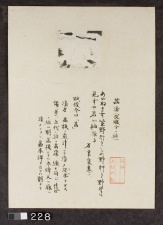Akane (Madder) - center (228 C) -missing
Revision as of 12:10, 22 June 2020 by MDerrick (talk | contribs) (MDerrick moved page Akane - center (228 C) -missing to Akane (Madder) - center (228 C) -missing without leaving a redirect)
| Museum number | 228 |
|---|---|
| Uemura number / title | ; "Haze-some 25" |
| Folder location | 4th shelf |
| Sample location | center (228 C) -missing |
| Fiber type | - |
| Color | - |
| Dyestuff (Japanese common name) | 茜根 : Akane |
| Dye (English common name) | madder |
| Dyestuff (botanical name) | Rubia argyi (H.Lv. et Vaniot) H.Hara ex Lauener (R. akane Nakai) |
| Plant part | root /dried (?) |
| Dyestuff extraction | boiled in water |
| Auxiliary agent in dye bath | - |
| Mordant | ash water |
| Other auxiliary agent | - |
| Uemura's notes | In classic Japanese poems compiled in the Manysh () from the 7th -8th Century AD, madder was often read to imply dawn: . This color is what was called "Hi ()" in the Ebukuryo () from the 8th century AD. The color "Hi" had been created by dyeing with madder during that period. The other color called "Sohi ()" from the same period was also produced by dyeing with madder. However, what was called "Hi" in later periods involved a different dyestuff. Dyeing madder on cotton or linen was difficult to achieve. What is called "Akane-momen ()" would not involve use of madder. |
| Uemura's date | Kyoto |
